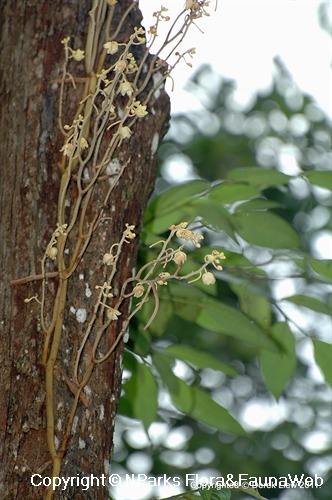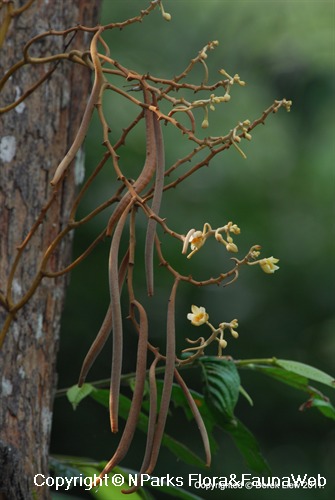
Back
Galeola nudifolia Lour.
| Family Name: | Orchidaceae |
| Synonyms: | Galeola kuhlii (Rchb.f.) Rchb.f., Galeola hydra Rchb.f., Galeola pterosperma Schltr. |
Name
Classifications and Characteristics
| Plant Division | Angiosperms (Flowering Seed Plants) (Monocotyledon) |
|---|---|
| Plant Growth Form | Climber |
| Lifespan (in Singapore) | Perennial |
Biogeography
| Local Conservation Status | Native to Singapore (Critically Endangered (CR)) |
|---|
Description and Ethnobotany
| Growth Form | Parasitic climber. |
|---|---|
| Stems | Stems stout, to 1 cm thick and 15 m or longer, each node with root and scale leaf, rusty red-brown in colour. Scale leaves broadly triangular, up to 2.5 cm long, reddish in colour. |
| Flowers | Inflorescence paniculate, terminal or in the axils of the upper scale leaves, branches 15-30 cm long or longer. Flowers yellow with orange-red veins inside, faintly smelling of overripe bananas. |
| Fruit | Fruits of G. nudifolia contain the largest orchid seeds in the world. The seeds are also winged, which is unusual. Upon dispersal of its seeds, the plant dies, leaving no trace of its existence. |
| Etymology | The species epithet, nudifolia, means "with simple, exposed leaves". |
Landscaping Features
| Desirable Plant Features | Ornamental Flowers |
|---|
Plant Care and Propagation
| Light Preference | Semi-Shade |
|---|---|
| Water Preference | Moderate Water, Occasional Misting |
| Plant Growth Rate | Fast to Moderate |
Floral (Angiosperm)
| Flower Colour(s) | Yellow / Golden |
|---|
References
| References | Keng, H., S.C. Chin and H.T.W. Tan. 1998. The Concise Flora of Singapore Volume II: Monocotyledons. Singapore: Singapore University Press. 215 |
|---|
Image Repository
Others
| Master ID | 30708 |
|---|---|
| Species ID | 5020 |
| Flora Disclaimer | The information in this website has been compiled from reliable sources, such as reference works on medicinal plants. It is not a substitute for medical advice or treatment and NParks does not purport to provide any medical advice. Readers should always consult his/her physician before using or consuming a plant for medicinal purposes. |

